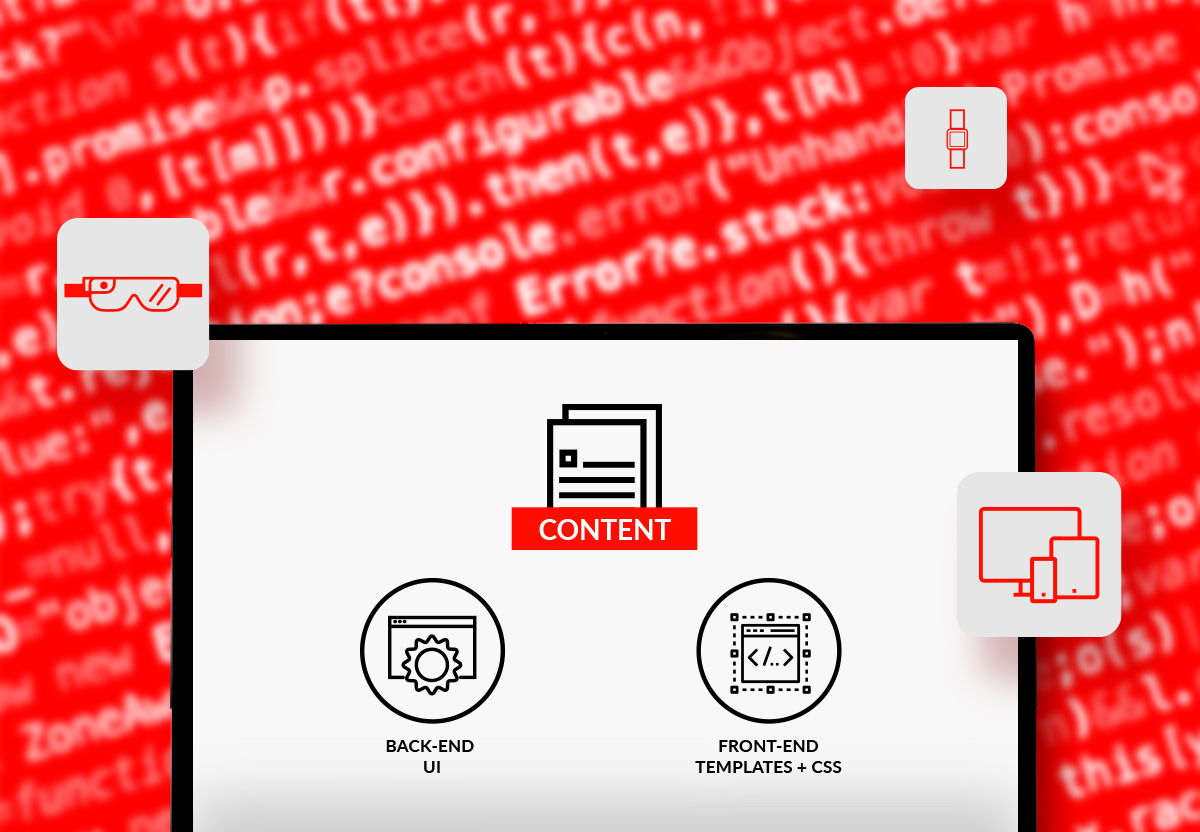What is a Headless CMS?
This article gives you a short overview of what a headless CMS is, about its benefits and how it is compared to traditional CMS solutions.
In a traditional CMS, the content and its display are closely coupled. Typically, pages are built and published using a WYSIWYG editor (What You See Is What You Get) and a defined templating system (often referred to as components, widgets, modules). Let’s assume that your distribution channel is a website. What if you need an additional channel, e.g. an Android or/and an iOS app?
What is a Headless CMS?
If you imagine a traditional CMS as a body, the “head” would be the front-end components like the front-end framework and templating system. If you remove that head, you’re left with a headless CMS.
A headless CMS separates content production, management, and storage from its distribution and display. It is used for the creation of raw content, without any concerns on how this data will be presented to end-users. The idea behind this is to make maintained data ready for consumption via content APIs (CaaS – Content-as-a-Service) and let developers build as many heads as their client needs, using the tools they prefer.
Head = distribution channel
Imagine all the possibilities you have: websites, mobile and desktop apps, chatbots, kiosks, billboards, smartwatches, and other IoT devices, or even voice-activated applications like Alexa, Cortana, and Siri.
Benefits:
- Focuses on raw content creation and audience building
- Content can be processed for multiple channels
- Easy integration into various systems
- Faster time to market (creators start working on content while the presentation is being developed)
- Future-proof
Challenges:
- Limited creative control over the content presentation (there is no WYSIWYG editor)
- Limited content personalisation support (no fun for marketers)
- High complexity (fragmented tech stack)
Introducing a Decoupled CMS
A decoupled CMS also referred to as a hybrid (headless) CMS, is a superset of a headless CMS. It keeps the same features and good traits of a headless CMS, but also comes with an important addition, a built-in templating system.
Now, you might ask yourself: “How is it different from a traditional CMS?” Well, the difference is that content and a templating system that is responsible for the display of this very content are not closely coupled. Content is still managed in the same way as in a pure headless solution, but in case of a decoupled CMS, there is a built-in templating system that knows how to access the raw content and how to display it.
An important fact here is that the templating system is an optional feature and you don’t have to use it. You are still free to build as many heads you need, but there is a built-in head available immediately ready for use, which makes operating your system very comfortable.
By offering a (decoupled) templating system, all challenges of a headless CMS can be resolved:
- creative control over the content presentation is regained (WYSIWYG editor)
- full-content personalisation support (marketers regain control on what is delivered to different user segments)
- the tech stack is simplified since front-end tech stack is included and you don’t have to look for one
A decoupled CMS keeps the best traits of both traditional and headless CMS.
Choosing the right CMS for your needs
Traditional, decoupled, or pure headless, all these variants still have their purpose, and depending on the use case, hold advantages over each other. For this reason, many enterprise-grade CMS frameworks (Magnolia CMS and Sitefinity, to name two frequently used CMS) offer all these different variants as part of its development workflow.
To help you choose the right CMS variant for your needs, we will explore several criteria.
How many channels do you need for delivering your content?
If the answer is more than one, e.g. a website combined with one or more mobile apps, we recommend choosing a decoupled or a headless CMS.
If the answer is just one and assuming it’s a website, a traditional CMS may be the right option for you. But let’s go through other criteria first.
Do you need an additional content delivery channel in the future?
Maybe you are starting with a website as a means of delivering your content, but you could need an additional channel for accessing your audience in the future (e.g. a mobile app or a second website). Choosing a decoupled CMS makes your investment future-proof.
Do you have much content and how frequently will you maintain it?
In case your website does not contain a lot of content or if your content is not maintained frequently, (like on a company website, for example) a pure headless solution would not fit very well. Then, using a traditional or a decoupled CMS would be the best solution.
In case you will have a lot of content, e.g. a magazine website, and new content is being created on a regular basis (daily, hourly), choosing a headless or a decoupled CMS is recommended. If you need control over the presentation of your content, a decoupled CMS would be your first choice and a headless CMS if the speed for delivering your content is important.
What level of control over your content do you need?
In case you need a high level of control over your content publishing process (different accessibility roles, approvals, etc.) or control over how and where your content is presented (WYSIWYG editor, content arrangement, styling, and personalisation) you should make your choice between a traditional or a decoupled CMS because they are much more flexible than pure Headless solutions.
What is your budget?
Naturally, costs are important, but it is more important to have a solution that offers better value for your needs. If you are confident that you will not need another content delivery channel in the future, choosing a traditional CMS can have a better value for you because development costs are generally lower.
Do you already have a solution based on a modern front-end framework?
If you have already built a non-CMS-based website by using a modern front-end framework like Angular, Vue, or React, choosing a headless CMS is highly recommended. Both solutions go hand in hand because both are built with an API-based architecture in mind, and chances are that a headless CMS can easily be integrated into your existing solution.
To sum it all up
If you need a CMS solution for distributing content through multiple channels or if you’d like to have this possibility as a future option, choosing a decoupled/headless CMS is recommended. A decoupled CMS provides traditional features like creative control over content presentation and its personalisation.
When dealing with a single-channel scenario, both traditional and decoupled CMS options offer extensive creative control over the content presentation, personalisation, and advanced publishing workflows, with the former CMS being slightly more cost-effective and the latter being more future-proof.
AUTHOR
Branislav Stanić





